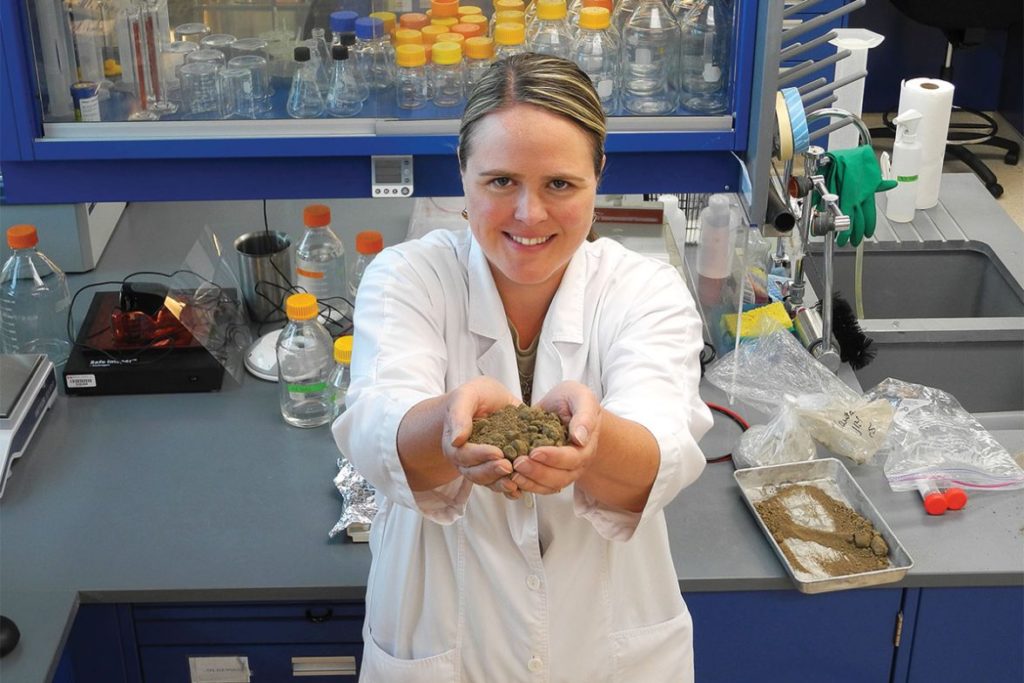
Understanding soil microbes could boost yields
Soil is sometimes considered the last knowledge frontier because so little is known about the microbial and fungal communities that live within it. What we do know is that in just a small handful of dirt live thousands upon thousands of microorganisms, some helpful to plant production, some not.
Soil health and crop production go hand in hand, which is why scientists, like Agriculture and Agri-Food Canada’s (AAFC) Claudia Goyer, are working hard to better understand it. Her work on soil microbes using next generation sequencing could help potato growers increase production. Research like hers is especially important as the number of mouths to feed grows steadily, while available land for production shrinks.
“A lot of people are really excited about the work in microbiology because it’s thought that microbes could come to our rescue,” said Goyer, who works at AAFC’s Fredericton Research and Development Centre in New Brunswick, Canada. “The hope is that we will better understand bacteria and fungal communities in soil.”
Goyer, a noted soil scientist and potato researcher, has been using next generation sequencing to better understand microbial and fungal communities in soil. In the first of two projects, she looked at how different potato cultivars impacted bacterial communities and pathogens, like common scab.
To do that, the scientists quantified pathogens in the soil and examined the bacterial communities of the different cultivars – two susceptible and two resistant – to see how they were changing over time and how each cultivar influenced the results.
“We were interested in better understanding how the pathogen changed over time and if there were differences between cultivars that are more susceptible and cultivars that are more tolerant or resistant to common scab,” Goyer said.
What Goyer saw, surprisingly, was that although the bacterial communities were changing over time, there was no major change between the cultivars.
“It’s a resounding no,” she said. “It doesn’t seem that the plant changes the bacterial communities and that leads to a change in the number of common scab pathogens. It’s probably more of a direct effect of the composition of the exudate from the roots from the different cultivars that directly affects the growth of Streptomyces.”
While the discovery – or lack thereof – was disappointing, it also helped the researchers understand how pathogens change and what key factors control disease in the field.
“It looks like one of the susceptible potato cultivars was harboring more of the pathogens,” she said. “So if you grow more susceptible cultivars, not only can you get more pathogens and lesions on your tubers, but what you leave behind, the roots decompose and the pathogen remains. The roots are harboring potentially more of the pathogen, so it’s like you have a bigger inoculant at the end.”
In the second study Goyer looked at how bacterial and fungal communities change in the varying topography of a potato field. “We wanted to know what the controls were for the spatial distribution of bacteria in a commercial potato field,” she said.
The study involved 83 sampling points in a one-kilometer long transect. The researchers took soil samples from each of the points and measured their soil properties, including pH, moisture, texture, and the concentration of nitrogen and soil organic carbon, to see how they related to topography, including elevation, aspect and curvature.
“What we found was that the range of soil pH was quite large – from 4.3 to 7.0 – and what we discovered is that soil pH and slope are highly and negatively correlated,” Goyer said. “We think what’s happening is that because that system has been under agriculture for a long time the soil at the top of the slope has lost its first layer and the sub-soil is very acidic.”
After analyzing the results, Goyer found that slope, soil organic carbon and pH were also important in explaining the diversity of bacteria in the soil. Goyer’s team also used geostatistics and looked at the distance at which there was a correlation between the diversity of microbial communities between samples and at what point that correlation ceases.
“Basically, the thought is that if you take two samples that are close, normally they are correlated, which means the diversity is similar in both samples,” Goyer said. “But as you increase the distance, it’s not very similar because it’s too distant.”
“When we look at the diversity of bacteria, we also saw that the spatial distribution was really close to pH and slope, so it’s correlated to a 40-meter distance,” she said.
What this means is that pH and slope are controlling factors for the diversity of those bacteria and fungi in that soil system. What makes these results of particular interest is that pH and soil organic carbon are factors that can be managed in agriculture by applying lime, manure or compost.
“What it indicated is that it is possible to influence the diversity of bacterial communities in fields,” Goyer said. “I think that’s exciting because in the future if we want to harness the power of microbes to sustain more crop productivity, then it is possible by simple actions to do this.”
Goyer said there’s still a lot of research needed in this area, but it’s work she’s excited to do. “If we want to increase crop productivity, better understanding what the microbes are doing and how they’re associated with plants, then harnessing this ability of the microbes to help grow more food is what every microbiologist dreams about,” Goyer said







